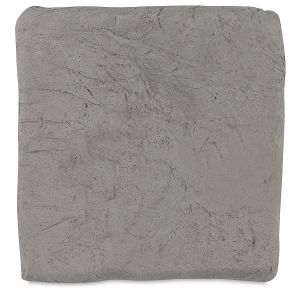Your cart is currently empty!
The Best Clay for Raku Pottery – Choosing a Raku Clay
Published:
Last Updated:
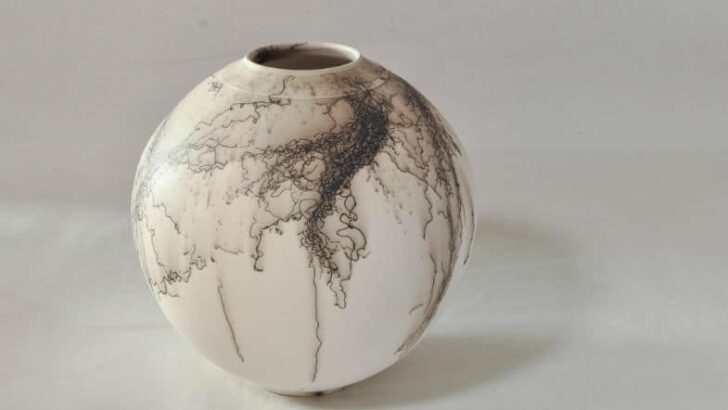
Affiliate Disclaimer
As an affiliate, we may earn a commission from qualifying purchases. We get commissions for purchases made through links on this website from Amazon and other third parties.
When I started looking into raku firing, I was keen to avoid my pottery cracking as it cooled. I knew that it was common for potters to lose their work as it was taken from the raku kiln. So, I started to look into what might be the best clay for raku pottery, and this is what I found out….
Grogged stoneware clay is suitable for raku firing. Grog helps make the pottery more resistant to thermal shock and reduces shrinkage. There are specially made raku clay’s that often contain kyanite. Porcelain can be raku fired if it contains a suitable grog, is well made, and is fired under 1200F.
Normally potters treat clay quite carefully, ramping the temperature of their kiln gradually up and down to avoid explosions. Raku is very different from this in two ways. Firstly, it is a fast-firing process that happens usually in the space of an hour. The clay is heated quickly.
Secondly, the clay is removed from the kiln, often when it is red hot. There are various different raku techniques once the clay is removed from the kiln. Never the less all these techniques involve the clay cooling down much quicker than it would with a normal firing.
Why Does Raku Pottery Crack During Firing?
When clay heats up and cools down, it goes through various stages of expansion and contraction. There is a particular point around 573C (1063F) where clay is being heated and cooled at which it expands sharply.
This is called the quartz inversion, so-called because the expansion happens both as the temperature rises and falls. Pottery is particularly vulnerable to cracking around this point in the heating and cooling process.
When raku pottery is taken out of the kiln, it undergoes rapid shifts in volume. This puts the clay body under a lot of stress, known as thermal shock. It is generally accepted amongst potters that there is a relatively high casualty rate in raku pottery. Cracks and explosions are taken as par for the course.
However, certain types of clay survive the extremes of raku more successfully than others. Let’s have a look at which clay bodies cope better with raku firing than others. I will look in turn at earthenware, stoneware, and porcelain clay. And then consider the pros and cons of specialist raku clay.
Is Earthenware the Best Clay for Raku Pottery?
Common sense suggests that because raku is a low fire process, then a low fire clay is your best option. Following on from this logic, earthenware pottery seems like a good choice for raku.
A raku kiln will typically fire to about 1,650F (898C). Earthenware clay matures at much lower temperatures than stoneware or porcelain. Generally, earthenware is glaze fired between 1,740 -1,920F (950-1,050C). Which would make it seem perfect for raku firing.
However, if you are using earthenware clay for raku, it is a good idea to consider the following. Because earthenware matures at lower temperatures, you may not get the same carbonization patterns typical of raku firing.
The more vitrified (glassy) a clay body has become, the less carbon will interact and blacken it. Although earthenware does not fully vitrify when it is fired it does reach its own highest maturity at lower temperatures.
For that reason, earthenware will not blacken through carbonization in the same way that higher fire clay bodies will blacken. It is therefore not ideal if you want intense black areas in your raku pottery.
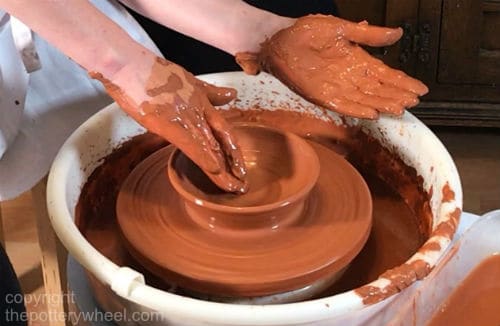
Is Stoneware the Best Clay for Raku Pottery?
Most of the time, stoneware is the clay of choice for raku pottery. However, it is much more likely to survive the raku process if it has additional materials to prevent it from cracking.
Grog can be added to clay bodies to make them more resilient. It can be made of various different materials. For example, grog can be made out of clay that has been fired and ground up into granules or powder. Sand can be used as grog. Also, a very refractory substance called kyanite is used as grog.
Each of these materials is referred to as being ‘opening agents’, which give clay a more open body. What this means is that they make the clay less dense. When grog is added to clay it creates distance between the unfired clay particles and opens the clay up.
Because grog is already vitrified, it does not expand and contract in the raku kiln. As such it reduces the amount of stress the clay is under during the temperature shifts in the raku process.
Some Things to Consider When Using Stoneware For Raku
- Course grog will be tough on your hands if you are throwing on the wheel. For example, crank clay which is coarsely grogged, has low shrinkage, and doesn’t warp when being fired. It is good for raku because it withstands changes in temperature. However, it is very rough and best for hand building or sculpting.
- Finer grogs, sand, and kyanite will make stoneware more resistant to cracking during raku firing. And they will be easier on the hands if you are throwing on the wheel.
- If your stoneware clay is not grogged, you can easily make it suitable for raku by wedging in some grog. A good rule of thumb is to add about 30% grog to stoneware to make it more refractory.
- It is best to have enough grog in your clay to make it more refractory. However, if you are making naked raku, a finer grog which will give you a smoother surface. This is important, as naked raku looks best if the clay surface is burnished smooth. A clay with a course grog will not burnish well.
- Thicker pieces are more vulnerable to thermal shock. So, if your pottery is going to be relatively thick, it’s a good idea to use a highly grogged clay. Or add a higher percentage of grog to the clay body.
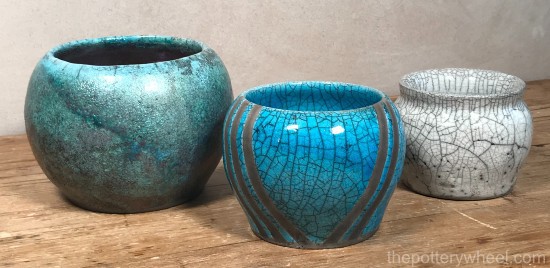
Clay Color – Stoneware
The color of clay that you use is really a matter of personal taste. Darker clays will make your glazes look earthier. Lighter-colored clays will brighten and showcase the color of your glaze.
Lighter-colored clay is more suitable for naked raku as it highlights the contrast of the carbonized patterns.
The mineral content in your clay body will also affect how well it performs in the raku process. Some stoneware clays have enough iron in them to give them a warm blush without the color being overpowering.
However, too much iron in your clay can interfere with carbonization. Earthenware has a relatively high iron content. This is another reason why stoneware clay is better than earthenware for raku.
Is Porcelain the Best Clay for Raku Pottery?
Porcelain is used by some potters for raku firing. However, it has a reputation for not tolerating the sudden drop in temperature when it is taken from the kiln. As such, with porcelain, there can be quite a high casualty rate with a high percentage of pots cracking.
Some suggested techniques that potters use to help porcelain survive raku firing are as follows:
- Fine grog can be added to porcelain to reduce cracking.
- Make your pottery with thin walls. And make sure there isn’t too much of a difference in thickness between the base and walls.
- Raku fire in the summer so that temperature drop isn’t too great when you remove your pottery from the kiln.
- Keeping the kiln temperature under 1200F (650C), avoids very extreme temperature changes when the pottery is removed.
This is particularly true if you are doing horsehair raku or using feathers. Porcelain raku can crack when the hair or feathers are applied to pottery that is too hot. - Let the pottery stay in the reduction chamber until it is almost cool.
- Allow the pottery to cool gradually in the reduction chamber rather than quenching it.
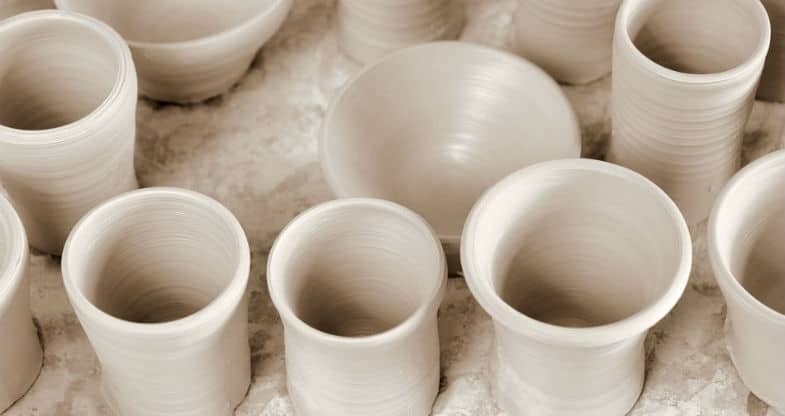
Mixed Opinions About Porcelain and Raku
In spite of these adaptations, there is still disagreement amongst potters whether porcelain is suitable for raku.
Some potters swear by porcelain clay for raku, arguing in favor of its smooth, white finish. Others argue that because the raku temperature is low, using porcelain is for raku is a waste.
Their argument is that because it is not fired hot enough, the clay doesn’t vitrify and become hard and translucent. As such, it’s argued that you may as well be using any other kind of clay body.
Ultimately it boils down to personal choice.
Another way to minimize the risks of using porcelain for raku is to buy a specially made porcelain raku clay. These clays are designed to withstand the raku process.
However, even specially formulated porcelain has to be handled carefully when raku firing. And the advice with this clay is to keep the walls of your pottery thin and even.
Nevertheless, it is still recommended that the pottery you raku from this porcelain is made thin and with an even cross-section.
This is only one of the special raku clays available, there are others. Let’s take a look at them now…
Is Special Raku Clay the Best Clay for Raku Pottery?
Raku clays made specifically for raku firing, are designed to have a high resistance to thermal shock. They also have a low shrinkage rate.
This is generally achieved by adding kyanite to the clay body. Kyanite is a mineral that is calcined to produce a substance called mullite. Calcination of a mineral involves firing it long enough to burn off volatile compounds, without melting it.
Mullite is a crystal structure made through the calcination of kyanite. It is very refractory and resistant to thermal shock. Therefore, mixing kyanite as a grog in various different clay bodies can make them more resilient in raku firing.
Experienced potters will often argue that a special raku clay is not essential. After all, most grogged stoneware will survive the raku process if it is made with even walls.
Some potters argue that a special raku clay is helpful if you are making larger items. This is because large items are at a higher risk of cracking. But possibly also because grogged clay is stronger and easier to make big pieces from.
This is a Standard Ceramic 239 Raku Clay. It’s an open clay body specially formulated to withstand the thermal shock of raku firing, Standard Ceramic 239 Raku Clay contains sand.
Bisque fire to Cone 04. Recommended firing is Cone 04. Shrinkage is 8% at Cone 04, and absorption is 17% at Cone 04.
Final Thoughts
My feeling is that when you are starting out making raku pottery, you have a lot to think about. Worrying about whether your pottery is going to crack when it comes out of the kiln is an additional concern. Using specially made raku clay may help eliminate some of that uncertainty, which I think is a good thing.
If you are just starting out, the best clay for raku pottery for you might be a special raku clay. Once you have become more confident, it may be time to experiment with other clays that offer less predictable results.

